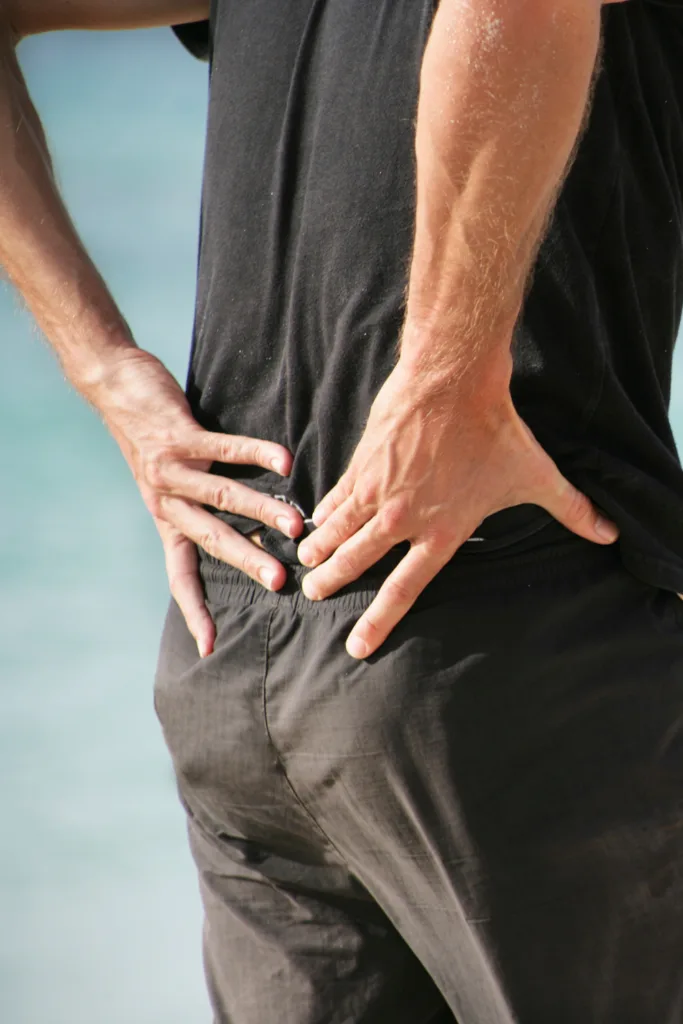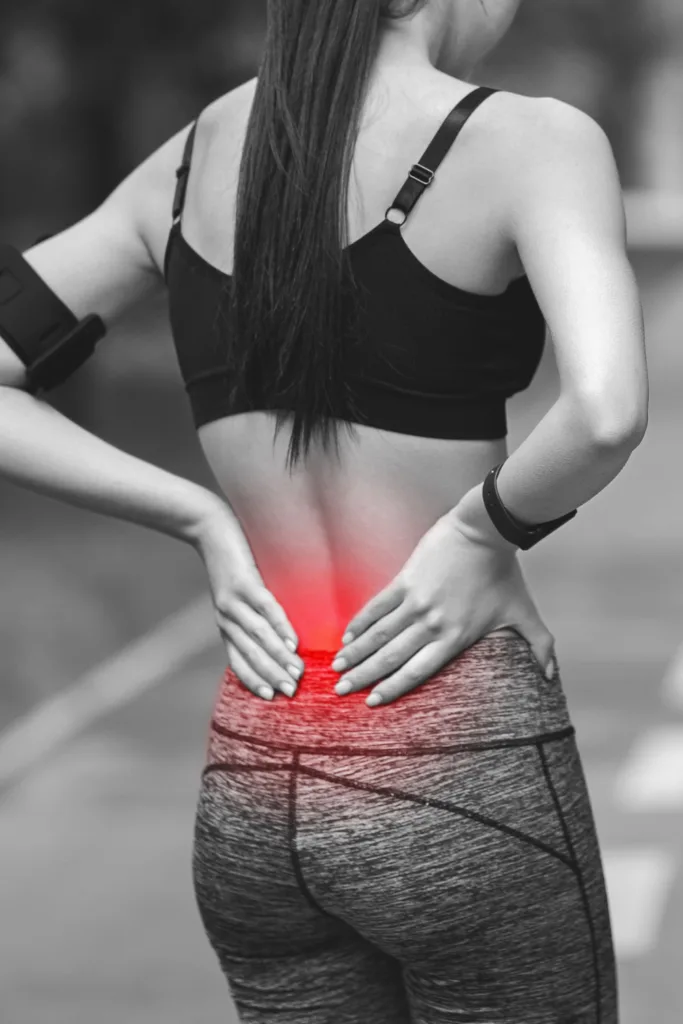Back pain, especially lower back pain, is a common injury for many people, including runners.
Symptoms of lower back pain can range from a minor irritation to pain that stops you in your tracks.
The good news is lower back pain usually improves in a matter of weeks, however, in some rare cases it can become chronic if left untreated.
So what exactly causes lower back pain after running? And how can you prevent it for good?
In this guide we’ll explore:
- What is lower back pain?
- What are the symptoms of lower back pain?
- What causes lower back pain after running?
- What conditions cause lower back pain?
- Who is at risk of developing lower back pain?
- How to treat lower back pain after running
- How to prevent lower back pain after running
Ready?
Let’s get started!

What is lower back pain?
According to a 2013 study, lower back pain is a common condition that up to 84% of adults will experience during their lives, and up to 54% of adults will have more than one episode.
The study adds that lower back pain is the second ranked cause of lost days at work, and approximately $50 billion per year is spent on lower back pain in the USA alone.
There are many sources responsible for lower back pain, including muscles, nerves, bones and referred pain from abdominal organs.
Interestingly, in a 2013 study conducted with 1,125 patients (46% male, 54% female) with lower back pain, the frequencies of the sources of pain were:
- Spine (61.2%)
- No cause found (14.5%)
- Spine with sacroiliac joint (6.4%)
- Spine with hip (5.8%)
- Hip (3.9%)
- Spine along with the hip and sacroiliac joint (1.8%)
- Hip with the sacroiliac joint (0.7%)
- Other diseases (0.4%)
Related: Heel pain after running: Causes + 8 ways to prevent it
What are the symptoms of lower back pain?
The severity of lower back pain varies from person to person.
Here are the main signs and symptoms:
- Pain in the lower back when running – this can range from a dull ache to a stabbing pain
- Pain in the buttocks
- Pain or tenderness over or around the two knobbly bony bits at the bottom of the lower back when running
- Pain that gets worse when you lean backwards or sideways
- Pain that gets worse when you lift something
- Pain that makes it difficult to bend down or put your shoes on
- Stiffness in the back
In some cases, lower back pain comes on with no apparent cause or reason.
Related: Hip pain after running: 8 causes + how to fix it

What causes lower back pain after running?
There are a variety of conditions that can cause lower back pain after running.
In most cases, lower back pain in runners is caused by muscle sprains and strains, weak lower back muscles and trigger points in the muscles.
With more and more people working from home, many are sitting for long periods of time which leads to your lower back and abdominal muscles becoming tight.
Here are the main causes of lower back pain after running:
- Muscle sprains and strains
- Weak core and lower back muscles
- Trigger points in the muscles
- Running gait issues
- Training overload
- Wearing worn out running shoes
Muscle sprains and strains
Excessive amounts of exercise can cause the muscles in your lower back to strain or tear.
This can result in pain and stiffness in the lower back.
Weak core and lower back muscles
If you have weakness in your lower back muscles, it’s more difficult to hold a strong and stable position when running, which can lead to loss of control.
Your lower back muscles are just as important as your core muscles when it comes to having a strong core.
Your core consists of the muscles surrounding your trunk, including the pelvic floor and glutes.
A weak core creates a whole host of imbalances and issues in your kinetic chain.
Weak core muscles cannot control movement, which leads to stress on the spine and pain in the lower back as a result.
Trigger points in the muscles
Weak muscles often cause cramping and trigger points to develop in the muscle in response to the stress put upon them through exercise.
These trigger points can cause pain when running.
The best way to alleviate pain from trigger points is to stretch and foam roll (also called myofascial release) to target the trigger points.
With more and more people working from home, many are sitting for long periods of time which leads to your lower back and abdominal muscles becoming tight.
Most runners will benefit from a basic stretching routine and basic core strength routine.
Running gait issues
If you overstride and run with a heel footstrike, you are more susceptible to having lower back pain issues.
A heel foot strike is when your heel hits the ground first when running, which causes impact forces to travel up your foot and ankle into your leg and hip, which in turn creates strain and pain.
It is preferable to run with a midfoot strike (this is when the middle of your foot hits the ground first) so as to distribute your weight evenly throughout the foot.
Training overload
If you take sudden leaps in your mileage or suddenly increase the intensity of your runs, then this can put extra load on your back.
Wearing worn out running shoes
Wearing worn out running shoes can cause a lot of issues and injuries throughout the entire body.
Flatfoot can be caused by wearing worn out running shoes, which is then the arches on the inside of your feet flatten when pressure is put on them.
This in turn puts strain on the bones in the spine which can cause lower back pain.
Related: Knee brace for running: When to wear one + where to buy
What conditions cause lower back pain?
Lower back pain generally can be caused by conditions like sciatica and a herniated disc.
Although symptoms of these conditions normally present before you go running and can be present for a number of weeks and months:
- Facet joint syndrome
- Sacroiliac joint dysfunction
- Hyperlordosis
- Herniated disc
- Sciatica
Facet joint irritation
Facet joint syndrome (also known as facet joint irritation) can be a significant source of pain and discomfort.
Found between the spine bones, facet joints connect each of your vertebrae and help promote healthy movement and promote stability in the spine.
You can think of the facet joint as a spacer between the vertebrae to support motion.
Pain occurs when the cartilage inside the facet breaks down and becomes inflamed, triggering pain signals in nearby nerve endings.
Facet joint syndrome is thought to be the leading cause of lower back pain.
Sacroiliac joint dysfunction
Dysfunction in the sacroiliac joint (also referred to as the SI joint) can cause lower back pain and leg pain.
The SI joint connects the hip bones to the sacrum which is the triangular bone between the lumbar spine and the tailbone.
They sit either side of the lowest part of the back above your buttocks – they are the two knobbly bits of bone in your lower back.
The primary function of the SI joint is to absorb shock between the upper body and pelvis and legs.
Too much or too little movement in the SI joint are causes of dysfunction:
- Too much movement (hypermobility) can cause instability in the pelvis which can lead to lower back pain, which can radiate to the hip and groin.
- Too little movement (hypomobility) can cause muscle tension, pain and may inhibit mobility. Pain is normally felt on one side of the lower back or buttocks, which can radiate down the back of the leg.
It is thought that SI joint dysfunction is responsible for 15% to 30% of lower back pain cases.
Hyperlordosis
Hyperlordosis is a type of poor posture, characterised by an exaggerated inward curve of the spine in your lower back.
As a result, your bottom pushes outwards and your stomach leans forward – like a C-shaped arch.
Obesity, structural issues and some neuromuscular diseases can cause hyperlordosis.
However, it does not generally require medical treatment. It can often be treated by improving your posture through stretching and exercise.
Herniated disc
A herniated disc (also known as a slipped disc) is when the inner part of the disc between your vertebrae pushes through the outer ring.
This is normally caused by wear and tear of the spinal discs as you age, eventually causing pain in the lower back.
The discs also absorb a lot of shock from activities like running, which causes them to weaken over time.
Sciatica
The sciatic nerve runs from your lower back to your feet.
Sciatica occurs when the sciatic nerve becomes irritated or compressed.
The main symptoms of sciatica are pain in your bottom, the back of your leg and foot and toes.
The pain may range from a numb, tingling sensation to stabbing, burning and shooting.
If you only have lower back pain, you probably don’t have sciatica as the pain is normally worse in your bottom, leg and foot.
Related: Knee pain after running: 10 causes + prevention tips

Who is at risk of developing lower back pain after running?
You are at risk of developing lower back pain after running if you:
- Take sudden leaps in your training (either by increasing the distance or intensity of your runs)
- Wear worn out running shoes
- Don’t warm up before a run
- Don’t perform a regular stretching routine
- Have a heel footstrike
- Run on hard surfaces regularly
Related: IT band syndrome: How to fix it + 7 training mistakes to avoid
How to treat lower back pain after running
The good news is there are many ways to treat lower back pain.
#1 Rest
As soon as you start to feel pain in your lower back when running, stop and try to identify the cause of the pain.
If you ignore or push through the pain, it could lead to further strain or injury.
#2 Use hot and cold therapy
If your back pain is acute and has been caused by a direct injury, use cold therapy first.
Lowering your body temperature will help to reduce swelling and inflammation.
Once the inflammation has subsided, use heat therapy.
The warmth will help to stimulate blood circulation in your lower back, which in turn brings about healing nutrients of the injured tissues.
Use heat therapy intermittently for several hours in order to improve tissue healing and prevent the recurrence of pain.
#3 Take pain medication
Pain medication such as ibuprofen and aspirin will help to reduce the pain and inflammation.
#4 Take a break from running
Take a break from running until the pain gets better and the inflammation disappears.
You should resume running only once the symptoms have cleared up.
#5 Do some gentle stretches
In the absence of any running, do some gentle stretches as these will help to speed up the recovery process.
Be mindful that some stretches may irritate the injury and inflame tissues, to be sure to check which stretches are best for you before starting your stretching routine.
#6 See a physiotherapist
If your lower back pain does not get better, you may be referred to a physiotherapist.
A physiotherapist will be able to advise on lower back exercise to improve movement, muscle strength, posture and flexibility.
They will also be able to help with pain management and provide hands on therapy such as massage and spine manipulation.
#7 See a chiropractor
A chiropractor uses spinal manipulation to help to make sure your body is functioning as optimally as possible.
Spinal manipulation can help to relieve pain in your joints and muscles, as well as increase blood flow and nerve conductivity to the joints and muscles that are experiencing pain.
#8 Try epidural injections
If you have severe sciatica, your healthcare professional may suggest an epidural injection.
These injections contain local anaesthetic and steroid to help relieve pain and reduce inflammation.
#9 Try radiofrequency denervation
If you have experienced lower back pain for a long time and it has become chronic, your healthcare professional may recommend a procedure called radiofrequency denervation.
This treatment is only suitable for certain types of back pain.
Your doctor will refer you to a specialist to assess whether it would help you.
Related: Taste blood when running? 7 causes + how to prevent it

How to prevent lower back pain after running
#1 Keep good posture
Proper running form and posture will help you run in the most efficient way possible so the least amount of stress is put on your muscles and joints.
Running form includes everything from your posture when running to your arm swing and cadence.
Check out our guide on proper running form for more information and tips.
#2 Warm up before each run
Muscles like the glutes and hamstrings are directly connected to your lower back, so if these become tight it can cause lower back pain.
Make sure you target these muscles in your pre-run warm up by doing some dynamic stretches.
#2 Move regularly
A sedentary lifestyle increases your risk of developing lower back pain.
Your muscles like the hamstrings, glutes, hip flexors and abs become tight and weakened as a result, which can have a negative impact on your running form and performance.
If you sit behind a desk all day for work, then find ways to move more regularly by stretching and going for walks.
#4 Mix up the terrain
If you’re used to running on hard surfaces and regularly experience lower back pain, then now is the time to switch up your training.
Opt to run on softer surfaces such as a treadmill.
If you cannot fathom the idea of running on a treadmill, then try trail running instead.
#5 Strength train
Strength training (also known as resistance training) will help you to stay strong and healthy as a runner.
By performing glute strengthening and lower back strengthening exercises on a regular basis, you will reduce the risk of injury in those areas and help to build stronger ligaments, tendons and muscles.
Aim to include 2-3 strength training sessions in your training routine each week.
#6 Progress slowly
As we mentioned earlier, sudden increases in your training is a contributing factor of lower back pain.
Make sure you increase your running slowly – whether that be the distance or intensity.
It is recommended you progress by 5-10% each week.
#7 Wear the right running shoes
Wearing the right running shoes will help to reduce the risk of many common running injuries, including lower back pain, shin splints and IT band syndrome.
Make sure you find a pair that are tailored towards your feet – that is your foot structure and gait pattern
If your foot rolls inwards or outwards when you run, for example, you can find shoes that cater to this gait pattern.
Check out our guide on how to find the running shoes for more information and tips.
- 5 things I wish I’d known before returning to running - March 3, 2024
- Running 20 minutes a day: Benefits + how to start - January 27, 2024
- How to run your first 2 hour half marathon - January 16, 2024
